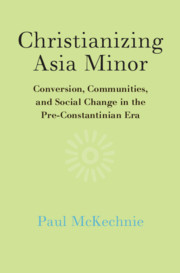Book contents
- Christianizing Asia Minor
- Christianizing Asia Minor
- Copyright page
- Contents
- Figures
- Abbreviations
- Preface
- Introduction
- 1 Phrygia in the New Testament
- 2 Hierapolis (Pamukkale)
- 3 Teachers of Asia: Ignatius, Polycarp, Paul and Thecla
- 4 Montanism Part 1: The Origins of the New Prophecy
- 5 Montanism Part 2: Pepuza and Tymion
- 6 Aberkios of Hierapolis (Koçhisar) and His Gravestone
- 7 Aberkios and the Vita Abercii
- 8 Apollonia (Uluborlu): Curiales and Their Families
- 9 Eumeneia (Işıklı) and the Eumeneian Formula
- 10 Christians for Christians
- 11 The Great Persecution and the Phrygian Fourth Century
- Book part
- Bibliography
- Index
3 - Teachers of Asia: Ignatius, Polycarp, Paul and Thecla
Published online by Cambridge University Press: 07 August 2019
- Christianizing Asia Minor
- Christianizing Asia Minor
- Copyright page
- Contents
- Figures
- Abbreviations
- Preface
- Introduction
- 1 Phrygia in the New Testament
- 2 Hierapolis (Pamukkale)
- 3 Teachers of Asia: Ignatius, Polycarp, Paul and Thecla
- 4 Montanism Part 1: The Origins of the New Prophecy
- 5 Montanism Part 2: Pepuza and Tymion
- 6 Aberkios of Hierapolis (Koçhisar) and His Gravestone
- 7 Aberkios and the Vita Abercii
- 8 Apollonia (Uluborlu): Curiales and Their Families
- 9 Eumeneia (Işıklı) and the Eumeneian Formula
- 10 Christians for Christians
- 11 The Great Persecution and the Phrygian Fourth Century
- Book part
- Bibliography
- Index
Summary
In the second century, Ignatius and Polycarp made an impact across Asia Minor. Ignatius, travelling under guard to Rome, wrote seven letters, six to churches and one to Polycarp, bishop of Smyrna. This may be behind Lucian’s idea of Peregrinus, the Cynic philosopher, before his death, sending ‘letters to all the glorious cities that were Last Wills and Testaments’. Polycarp, Ignatius’ addressee, died in Smyrna in 155, after visiting Rome the year before. As a teacher of Christianity, Polycarp challenged the established sacred canopy – a system taught (at the elite level, in Smyrna) by Scopelian of Clazomenae. Polycarp’s contacts included people whose children would have been Scopelian’s students. He performed for the masters and mistresses of the world. Polycarp, by contrast, spoke from outside the dominant culture, so that listening to him constituted a ‘journey into darkness’ (Peter Berger). Paul and Thecla, the story of a woman from Iconium converted to Christianity because of Paul the Apostle, was written in Asia Minor after Polycarp’s time. A tract in novelistic form commending sexual continence, Paul and Thecla offers an insight into the Asian Christian experience.
- Type
- Chapter
- Information
- Christianizing Asia MinorConversion, Communities, and Social Change in the Pre-Constantinian Era, pp. 68 - 95Publisher: Cambridge University PressPrint publication year: 2019



